Original research
Peer reviewed
Economics of increasing lysine:calorie ratio and adding dietary fat for growing-finishing pigs reared in a commercial environment
Manuel De La Llata, MS, PhD; Steve S. Dritz, DVM, PhD; Michael R. Langemeier, MS, PhD; Mike D. Tokach, MS, PhD; Robert D. Goodband, MS, PhD; Jim L. Nelssen, MS, PhD
MDLL, MDT, RDG, JLN: Department of Animal Sciences and Industry; MRL: Department of Agricultural Economics; SSD: Food Animal Health and Management Center, Kansas State University, Manhattan, Kansas 66506-0201
SSD: Food Animal Health and Management Center, Kansas State University, College of Veterinary Medicine, 1800 Dennison Avenue, Manhattan, Kansas 66506. Tel: 785-532-4202; Fax: 603-676-5543; E-mail: dritz@vet.ksu.edu
Contribution No. 00-445-J of the Kansas Agric Exp Stat, Manhattan, Kansas 66506.
Address correspondence to Dr Dritz.
De L Llata M, Dritz SS, Langemeier MR, et al. Economics of increasing lysine:calorie ratio and adding dietary fat for growing-finishing pigs reared in a commercial environment . J Swine Health Prod. 2001;9(5):215-223. Available as a PDF
Summary
Objective: To evaluate the economics of adding dietary fat and increasing lysine:calorie ratios in growing-finishing pigs reared in commercial swine facilities.
Methods: Data was collected from 1200 gilts (initially 27 kg) and 1200 barrows (initially 34 kg). Two levels of fat (0% and 6% added choice white grease) and four lysine:calorie ratio regimens (LCR) arranged in a 2 x 4 factorial were examined. Monthly prices of corn, soybean meal, fat, and hogs for 1989 to 1998 were used to calculate feed cost, feed cost per kg of gain, and income over feed cost (IOFC) under two packing-plant pricing grids.
Results: Adding fat and increasing LCR increased ADG, G:F, and feed cost per pig. For gilts, feed cost per kg of gain was lowest in 39.2, 15.0, and 4.2% of months for LCR2, LCR3, and LCR4 without added fat, respectively; and in 41.6% of months for LCR4 with added fat. The IOFC was highest in 98.3 and 100% of months for LCR4 with added fat using Grids One and Two, respectively. For barrows, feed cost per kg of gain was lowest in 84.4% of months for LCR3 without added fat. Using Grid One, IOFC was highest in 55 and 45% of months for LCR4 with or without added fat, respectively. Using Grid Two, IOFC was highest in 97.0% of months for LCR4 with 6% added fat.
Implication: For evaluation of nutritional programs, IOFC is a better indicator of economic performance than feed cost per pig or feed cost per unit of gain.
Keywords:  swine, lysine,
energy, added fat, economics
swine, lysine,
energy, added fat, economics
Received: June 12, 2000
Accepted: April 6, 2001
The energy content of the diet generally determines the amount of feed consumed by growing-finishing pigs.1 Consequently, as energy content increases, the amino acid levels of the diet must increase proportionately. Since lysine is the most common limiting amino acid, the proportion of amino acids to energy is commonly expressed as the lysine:calorie ratio. Several studies have shown that increasing the lysine:calorie ratio in diets for growing-finishing pigs improves average daily gain (ADG) and feed efficiency (G:F).2,3,4 Increasing energy content by adding fat to the diet also increases ADG and G:F, and decreases average daily feed intake.5,6,7 Although adding fat and additional amino acids to the diet improves growth performance, feed cost also increases. Therefore, economics should dictate the inclusion of fat and additional amino acids in diets for growing-finishing pigs. The growth response to added fat appears to be different in controlled research settings compared to commercial farms8 because of the 25 to 40% greater feed intakes of pigs housed under controlled environments. The objective of this study was to evaluate the economics of adding dietary fat and increasing lysine:calorie ratios in growing-finishing pigs reared in commercial swine facilities.
Materials and methods
Animals
This study included two experiments with a total of 2400 growing-finishing pigs (PIC C22 x 337). Experiment One was conducted with gilts (n=1200; initially 27 kg) from July to November 1998. Experiment Two was conducted with barrows (n=1200; initially 34 kg) from August to December 1998.
Diets
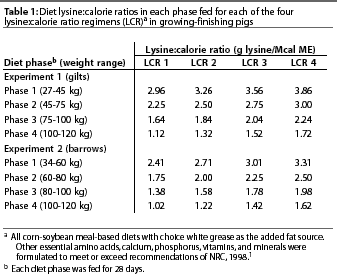 For both experiments, the corn-soybean
meal-based diets were arranged in a 2 x 4 factorial with two levels
of added fat (0 and 6% choice white grease) and four increasing
lysine:calorie ratios in each phase (Table 1). Thus, the four
lysine:calorie ratios with and without added fat across four phases
resulted in 32 diets fed across the four lysine:calorie ratio
regimens (LCR) for each experiment. Other essential amino acids,
calcium, phosphorus, vitamins, and minerals were formulated to
meet or exceed recommendations of NRC, 1998.1 Each
diet phase was fed for a 28-day period. The average pig weights
for each of the four phases were 27 to 45, 45 to 75, 75 to 100,
and 100 to 120 kg for Experiment One and 34 to 60, 60 to 80, 80
to 100, and 100 to 120 kg for Experiment Two. A more detailed
description of the diets is presented in De La Llata et al.9,10
For both experiments, the corn-soybean
meal-based diets were arranged in a 2 x 4 factorial with two levels
of added fat (0 and 6% choice white grease) and four increasing
lysine:calorie ratios in each phase (Table 1). Thus, the four
lysine:calorie ratios with and without added fat across four phases
resulted in 32 diets fed across the four lysine:calorie ratio
regimens (LCR) for each experiment. Other essential amino acids,
calcium, phosphorus, vitamins, and minerals were formulated to
meet or exceed recommendations of NRC, 1998.1 Each
diet phase was fed for a 28-day period. The average pig weights
for each of the four phases were 27 to 45, 45 to 75, 75 to 100,
and 100 to 120 kg for Experiment One and 34 to 60, 60 to 80, 80
to 100, and 100 to 120 kg for Experiment Two. A more detailed
description of the diets is presented in De La Llata et al.9,10
Housing and feeding
Pigs were housed in identical, double curtain-sided, deep pit research barns constructed like commercial finishing facilities, with forty-eight 3.05 m x 5.50-m pens and totally slatted concrete floors. The barns were ventilated naturally during warm weather and mechanically during cold weather.
Upon arrival from the nursery, pigs were allotted randomly to pens, with 25 pigs per pen, providing 0.67 m2 per pig. There was one four-hole self-feeder and one cup waterer in each pen. Pigs had ad libitum access to food and water throughout the experiments.
Growth performance
In each experiment, group weights of all the pigs in each pen were obtained every 14 days. Feed was weighed and added to the feeders using an auger cart equipped with a scale. Feeders were vacuumed, and the remaining feed was recorded at the diet phase changes every 28 days. Average daily gain, feed disappearance, and feed efficiency were calculated. At the end of the last phase, all pens were weighed before transport to a USDA-inspected processing plant. Prior to transport, the pigs in each pen were marked with a distinctive tattoo to allow the individual carcass data to be identified with the pen of origin. All pigs within each gender were marketed on a single day. Standard carcass criteria measured included carcass weight, fat and loin depths, and lean percentage.
Economic data collection
Prices used in calculations for corn, soybean meal, fat, and hogs (Figures 1 and 2) were collected monthly in the state of Minnesota for a ten-year period (1989 to 1998). Corn and hog prices were obtained from the National Agricultural Statistics Service,11 and fat (Minneapolis choice white grease) and soybean meal (Minneapolis high protein) prices from Feedstuffs.12 All prices were adjusted for inflation using the consumer price index from the US Department of Labor, Bureau of Labor Statistics.13
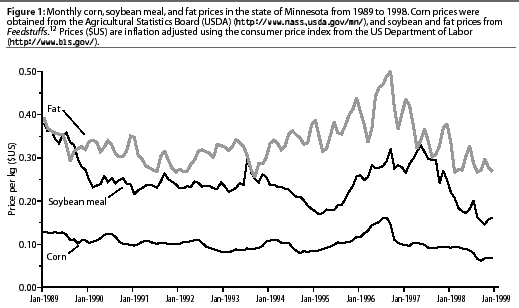
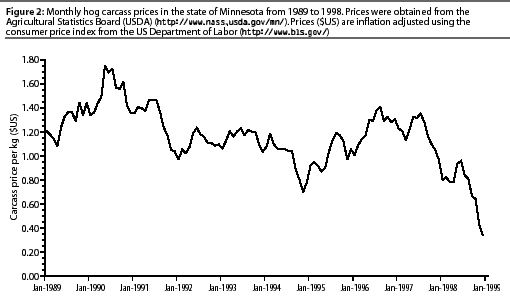
Economic calculations
Total feed cost per pig, feed cost per kg of gain, and income over feed cost (IOFC) per pig were calculated monthly for each treatment for each month of the ten-year data collection period. Total feed cost per pig was calculated using the monthly ingredient prices and the amount of feed consumed by phase for each of the dietary treatments. Feed cost per kg of gain was calculated by dividing the total feed cost per pig by the total kg of body weight gained. Income over feed cost per pig was determined by subtracting the feed cost per pig from the gross income per pig for each treatment. Gross income per pig was determined using monthly hog prices collected for the ten-year period plus premiums and discounts using the carcass measurements and two packing-plant grids. The same base price (based on monthly hog price) was used for both grids. Grid One used fixed premiums and weight discounts, which were independent of the base price (Table 2). Grid Two used an index of premiums and discounts, which represented a percentage of the base carcass price (Table 3).


Statistical analysis
Average daily gain, G:F, carcass weight, carcass lean, total
feed cost, feed cost per kg of gain, and IOFC were analyzed as
a completely randomized design using GLM procedures.14
The data were analyzed as a
2 x 4 factorial arrangement with main effects of added dietary
fat (0 or 6%) and with linear and quadratic polynomial contrasts15
to determine the effect of increasing the lysine:calorie ratio.
Pen was the experimental unit for all calculations.
Regression analysis
A multiple regression analysis for each of the dietary treatments was performed using the data analysis regression tool of Excel(R) described by Ragsdale.16 The following regression model was fitted to the data:
IOFC = bo + b1Corn + b2SBM + b3Fat + b4Hog price
Income over feed cost per pig for each month during the ten-year data collection period was used as the dependent variable. Prices of corn, soybean meal, fat, and hog carcasses for the same ten-year period were used as the independent variables.
Elasticity
Regression results are easier to interpret if the relationship between independent and dependent variables is expressed in percentage terms. An elasticity measures the effect on the dependent variable of a 1% change in an independent variable. The elasticity of Y with respect to X2, for example, is the percentage change in Y divided by the percentage change in X2. For each of the dietary treatments, the elasticities of the independent variables were calculated according to Pindyck and Rubinfeld17 using the following equation:
where E is the elasticity for the jth variable, [beta]
is the regression coefficient of the independent variable (ingredient
or hog price), ![]() is the average
price of the independent variable, and Y is the average value
of the dependent variable (IOFC). The impact of elasticity on
the dependent variable increases with increasing absolute values
of elasticity.
is the average
price of the independent variable, and Y is the average value
of the dependent variable (IOFC). The impact of elasticity on
the dependent variable increases with increasing absolute values
of elasticity.
Results
Growth and economic performance
Experiment One (gilts)
A more detailed description of the growth performance data is presented in De La Llata et al.9 Briefly, adding 6% dietary fat (P<.05) and increasing the lysine:calorie ratio (P<.05 linear) increased ADG, G:F, carcass weight, total feed cost per pig, and IOFC (Table 4). Carcass lean decreased with 6% added dietary fat (P<.05), and increased when the LCR increased (P<.05 linear). Feed cost per kg of gain increased (P<.10) when 6% added fat was included in the diet. No significant interactions between fat and LCR were observed (P>.41). The fourth LCR with 6% added fat resulted in the highest IOFC in 98.3% (Grid One) and 100% (Grid Two) of the months during the ten-year data collection period. The fourth LCR without added fat resulted in the highest IOFC in only 2 months for Grid One (1.7%). When no fat was added to the diet, feed cost per kg of gain was lowest in 39.2% of months for the second LCR, 15.0% of months for the third LCR, and 4.2% for the fourth LCR. When 6% fat was added to the diet with the fourth LCR, feed cost per kg of gain was lowest in 41.6% of months.
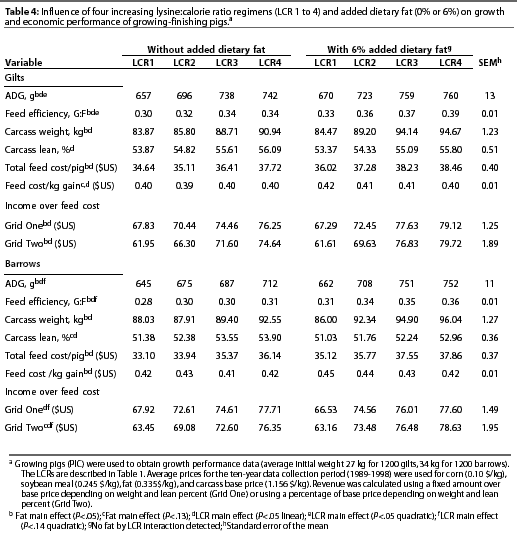
Experiment Two (barrows)
Adding 6% dietary fat (P<.05) and increasing the LCR (P<.05 linear) increased ADG, G:F, carcass weight, and total feed cost per pig (Table 4). Carcass lean decreased with 6% added dietary fat (P<.05), and increased when the LCR increased (P<.05 linear). Adding 6% fat to the diet did not affect IOFC for Grid One (P>.56), but tended to increase IOFC for Grid Two (P<.10). Increasing the LCR increased IOFC for both grids (P<.05 linear). Feed cost per kg of gain increased (P<.05) when 6% fat was included in the diet. Increasing the LCR decreased feed cost per kg of gain (P<.05 linear). No significant interactions between fat and LCR were observed (P>.41).
For Grid One , the fourth LCR with 6% added fat resulted in the highest IOFC in 46.7% of the months, and the fourth LCR with no added fat resulted in the highest IOFC in 53.3% of the months. For Grid Two, the fourth LCR with 6% added fat resulted in the highest IOFC in 97.0% of the months. The fourth LCR without added fat resulted in the highest IOFC in only 4 months (3.0%). Feed cost per kg of gain was lowest in 84.4% of months for the third LCR with no added fat and in 15.6% of months for the fourth LCR with 6% added fat.
Regression and elasticity
In both experiments, regression coefficients were negative for corn, soybean meal, and fat prices, and the greatest absolute value was observed for the corn price coefficient (Table 5). The regression coefficient for hog price was positive, and it had the greatest elasticity value for each treatment in both experiments (Table 6). Fat price had the lowest elasticity value, followed by soybean meal and corn prices. When the lysine:calorie ratio of the diet was increased, elasticities decreased for corn, fat, and hog prices, and increased for soybean meal price.
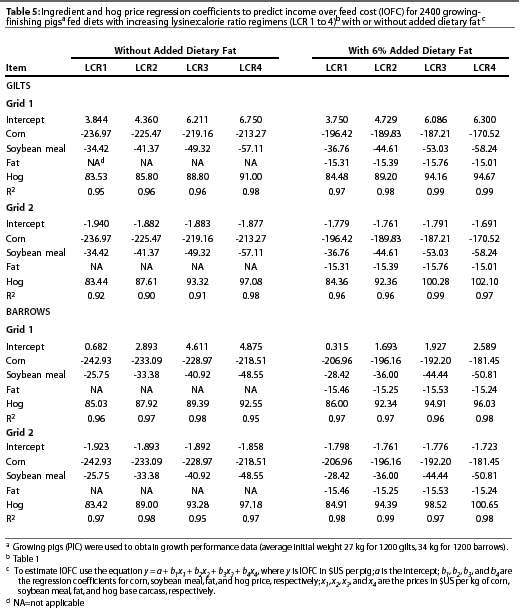
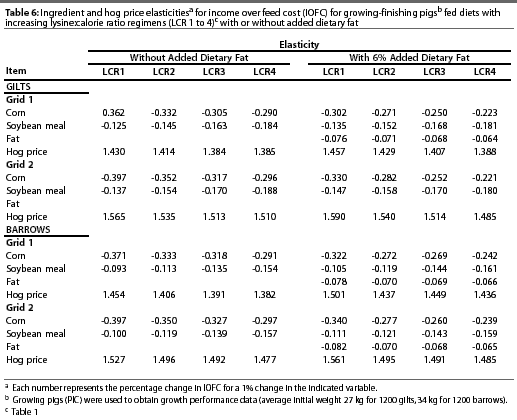
Discussion
Swine producers use various economic parameters to evaluate nutritional programs; total feed cost per pig is one of them. In this study, feed cost per pig was increased approximately 13.5% for the highest LCR with 6% added fat compared to the lowest LCR with no added fat. However, adding fat or increasing the LCR resulted in increased growth performance. Feed cost per unit of gain is another economic parameter widely used to evaluate nutritional programs. We observed that feed cost per unit of gain was lower for the diets without added fat. Feed cost per unit of gain was lowest for diets containing no added fat in approximately 60% of months in the ten-year period for gilts, and in approximately 80% of months for barrows. For gilts, the diet with the second lowest LCR and no added fat accounted for almost 40% of the months when feed cost per unit gain was lowest. These results suggest that feeding diets without added dietary fat and with lysine levels below the pig's requirement for maximum growth result in the lowest feed cost per unit gain during a large percentage of the ten-year data collection period.
In addition to examination of costs, nutritional programs should be evaluated in terms of margin and volume produced. When we evaluated the data in terms of IOFC, we observed that the LCR resulting in the best performance was associated with the highest IOFC estimate, even though feed cost was increased. We have observed similar results in several swine production systems. Systems that focus almost solely on cost control tend to feed diets that are slightly lysine deficient and lower in added fat, which results in slightly submaximal growth performance. Conversely, systems that also focus on evaluating parameters influenced by income tend to feed slightly higher lysine and added fat levels to maximize growth performance.
Income over feed cost was highest in both experiments in almost 100% of the months when the fourth LCR was fed with added fat, except for Experiment Two (barrows) under Grid One. We examined the price conditions for the periods where the fourth LCR with or without added fat showed higher IOFC for Experiment Two (Figure 3). We observed that when addition of dietary fat increased IOFC (approximately 53% of the months), carcass price was 28% higher and fat price was 7% lower than during the period when the fourth LCR without added fat resulted in higher IOFC (approximately 47% of the months).
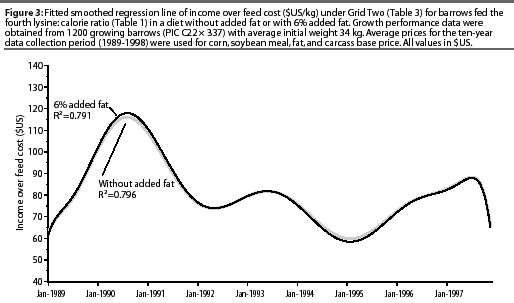
Percent lean decreased for both barrows and gilts when fat was added to the diet. However, IOFC increased for barrows and not for gilts during a large portion of the period evaluated under Grid One when the fourth LCR was fed without added fat. One explanation for this might be that gilts are leaner than barrows,18 and the decrease in percent lean (which resulted in lower revenue) when fat was added to the diet was greater for barrows than for gilts. Grid One tended to have a lower tolerance for dietary fat than Grid Two. For example, Figure 4 shows the highest fat breakeven price that could be paid to make IOFC the same for barrows fed the fourth LCR with and without added fat at different hog prices. Although both packing plant grids show an increase in the price that may be paid for fat as hog price increases, Grid One demonstrates a lower fat breakeven price across the hog price range studied.
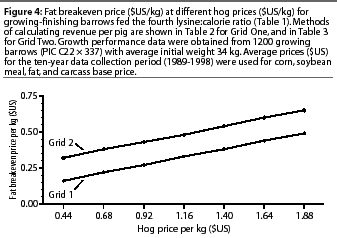
Regression coefficients
The regression coefficients obtained from monthly ingredient and hog prices over a ten-year period represent a wide range of market situations. These regression coefficients can be used to estimate IOFC for diets with the LCRs evaluated in this study (with or without added fat) by simply entering specific ingredient and hog prices into the equations. For example, using the regression equation for gilts (Experiment One) under Grid One for the fourth LCR with 6% added fat [IOFC = 6.30 + (corn price x -170.52) + (SBM price x - 58.24) + (fat price x -15.01) + (hog price x 94.67)] and the average ingredient and hog carcass prices ($US) for the ten-year data collection period ($0.10 per kg of corn, $0.25 per kg of soybean meal, $0.33 per kg of fat, and $1.16 per kg of hog carcass), we can calculate an IOFC of $79.50 per pig. If a producer, under similar conditions, pays an additional $0.09 per kg for fat due to differing delivery charges, heating costs, volume purchased, or fat source, the calculated IOFC for this producer is $78.20 per pig (a decrease of $1.20 per pig). If the producer in the previous example, in addition to paying a higher price for fat, also sells pigs at a base carcass price $0.04 per kg below the average, then the calculated IOFC will be $74.41 (a reduction of $5.00 per pig from the original figure). Another example illustrates a situation in which adding fat is less profitable than not adding fat. Using the ten-year average prices, we already calculated that a producer feeding gilts with the fourth LCR with added fat (under Grid One) will have an IOFC of $79.50. If another producer is also feeding gilts with the fourth LCR, but without added fat, and is selling pigs under Grid One at a price $0.05 per kg higher than the average price, the IOFC using the corresponding regression equation [IOFC = 6.75 + (corn price x -213.27) + (SBM price x - 57.11) + (hog price x 91.0)] will be $81.26 (an increase of $1.76 per pig).
Elasticity coefficients
Calculation of elasticity coefficients is a useful economic tool to determine the relative importance of independent variables in a regression analysis. The greatest elasticity value for IOFC was observed for hog price. This means that hog price has the greatest impact on IOFC. The elasticity coefficients for corn, soybean meal, and fat prices have negative signs, indicating that an increase in the price of any of the ingredients will result in a reduction of IOFC. For example, using elasticity coefficients under Grid One for the fourth LCR with 6% added fat in Experiment Two (barrows), we observe that a 1% increase in corn price will decrease IOFC by 0.24%. Similarly, IOFC will decrease by 0.16% with a 1% increase in soybean meal price, and 0.07% with a 1% increase in fat price. Conversely, IOFC will increase by 1.44% with a 1% increase in hog price.
It is not surprising that corn and soybean meal prices have a greater impact on IOFC than fat price, because they comprise the largest percentage of the feed cost. However, the opportunity margin, defined as the average percentage of each ingredient cost that may be available for increasing profit, is greater for fat.19 Although a change in corn or soybean price will have a greater impact on IOFC than a comparable change in fat price, the likelihood and the magnitude of a price change are greater for fat than for corn or soybean meal. Similarly, although hog price had the greatest elasticity coefficient, it might be more difficult for a producer to increase the hog price per kg than to decrease the price of corn, soybean meal, or fat. The high opportunity margin of fat price results from the large variability in fat prices among producers. This variability is explained by the differences in price between fat sources, volume purchased, delivery charges, and storage costs, as well as differences in negotiating ability among producers.
Summary
In our study, we determined that IOFC was a better economic evaluator than feed cost per kg of gain. This result applies to situations in which treatment differences influence revenue-affected parameters such 20 Income over feed cost takes both revenue and expenses into account, whereas feed cost per kg of gain focuses only on the expense side. The main factors that influence revenue are weight, lean premium, sort discount, and base price. The most important factors that influence expenses are feed cost and feed efficiency. Income over feed cost is a marginal return measure; therefore, producers should focus either on factors that would decrease feed costs without affecting productivity, or factors that would increase revenue. However, when producers try to increase revenue by adding components to the diet (eg, energy, a growth promoting agent to increase carcass weight, or a carcass modifier to increase lean premium), the increase in revenue must be greater than the increase in feed cost.
In this experiment, all pigs were marketed at the same time, allowing pigs with greater rates of gain to achieve heavier weights at market and, consequently, fewer sort discounts and more revenue. Under this circumstance, weight was the most important driver to maximize return. The fourth LCR with added fat maximized both growth and IOFC. However, marketing all pigs at the same time is also a potential limitation of this study. More research is needed to evaluate IOFC under conditions where slower growing finishing pigs are sold at a weight similar to that of faster growing pigs fed dietary fat. The extra gross income received by extending the feeding period to grow the pigs to heavier weights would have to justify the extra facility and feed costs.
Implications
- Different diet recommendations may result when different economic parameters are used to evaluate swine diets, for example, feed cost per unit of gain and income over feed cost.
- When swine diets are evaluated using income over feed costs, the selection of marketing strategy and barn close out procedure may have an impact on the results.
- Regression equations based on growth performance data can be developed to predict economic performance under specific market situations.
Acknowledgements
Appreciation expressed to Global Ventures for the use of pigs and facilities; to Pipestone Research Partners for partial financial support; and to Marty Heintz, Steve Rops, and Robert Powell for technical assistance.
References -- refereed
1. National Research Council. Nutrient Requirements of Swine. 10th ed. Washington, DC: National Academy Press; 1998.
2. Rao DS, McCracken KJ. Effect of protein intake on energy and nitrogen balance and chemical composition of gain in growing boars of high genetic potential. Anim Prod. 1990;51:389-397.
3. Chiba LI, Lewis AJ, Peo ER Jr. Amino acid and energy interrelationship in pigs weighing 20 to 50 kilograms: I. Rate and efficiency of weight gain. J Anim Sci. 1991;69:694-707.
4. Castell AG, Cliplef RL, Poste-Flynn LM, Butler G. Performance, carcass and pork characteristics of castrates and gilts self-fed diets differing in protein content and lysine:energy ratio. Can J Anim Sci. 1994;74:519-528.
5. Southern LL, Watkins KL, Ojeda AR, Hembry FG. Effect of season of the year and energy density of the diet on growth, feed intake, and feed efficiency of swine. Nutr Rep Int. 1989;40:1029-1039.
6. Pettigrew JE, Moser RL. Fat in swine nutrition. In: Miller ER, Ullrey DE, Lewis AJ, eds. Swine Nutrition. Stoneham, Massachusetts: Butterworth-Heinemann; 1991:33-146.
7. Smith JW II, Tokach MD, O'Quinn PR, Nelssen JL, Goodband RD. Effects of dietary energy density
and lysine:calorie ratio on growth performance and carcass characteristics of growing-finishing pigs. J Anim Sci. 1999;77:3007-3015.
8. De La Llata M., Dritz SS, Tokach MD, Goodband RD, Nelssen JL. Effects of dietary fat on growth performance and carcass characteristics of growing finishing pigs reared in a commercial environment. J Anim Sci. In press.
14. SAS. SAS/STAT(R) User's Guide (Release 6.03). Cary, NC: SAS Inst. Inc; 1988.
15. Peterson RG. Design and Analysis of Experiments. New York: Marcel Dekker. 1985;104.
16. Ragsdale CT. Spreadsheet Modeling and Decision Analysis. 2nd ed. Cincinnati: South-Western College; 1998.
17. Pindyck RS, Rubinfeld DL. Econometric Models Economic Forecast. 4th ed. New York: McGrawHill; 1997.
18. Friesen KG, Nelssen JL, Unruh JA, Goodband RD, Tokach MD. Effects of the interrelationship between genotype, sex, and dietary lysine on growth performance and carcass composition in finishing pigs fed to either 104 or 127 kilograms. J Anim Sci. 1994;72:946-954.
References -- non refereed
9. De La Llata, Dritz SS, Tokach MD, Goodband RD, Nelssen JL. Effects of increasing lysine:calorie ratio and dietary fat addition on growth performance and carcass characteristics of growing-finishing gilts. Kansas Swine Industry Day Report of Progress 841. 1999:88-91.
10. De La Llata, , Dritz SS, Tokach MD, Goodband RD, Nelssen JL. Effects of increasing lysine: calorie ratio and dietary fat addition on growth performance and carcass characteristics of growing-finishing barrows. Kansas Swine Industry Day Report of Progress 841. 1999:92-95.
11. National Agricultural Statistics Service. Agricultural Prices Monthly (PAP-BB). Various issues 1989-1998. http://usda.mannlib.cornell.edu/reports/nassr/price/pap-bb/ . Accessed July 13, 2001.
12. Weekly Ingredient Price Column. Feedstuffs. Minnetonka, Minnesota. 1989-1998.
13. United States Department of Labor, Bureau of Labor and Statistics. http://www.bls.gov/cpihome.htm. Accessed July 13, 2001.
19. Dritz SS, Tokach MD, Goodband RD, Nelssen JL. Feeding programs to increase margin and maximize throughput. Proc Allen D Leman Swine Conf. 1999;26:153-156.
20. Fuchs L, Reeves D, Morrison B. Using the return on equity (ROE) tree to help manage a business. Proc Allen D Leman Swine Conf. 1999;26:132-137
